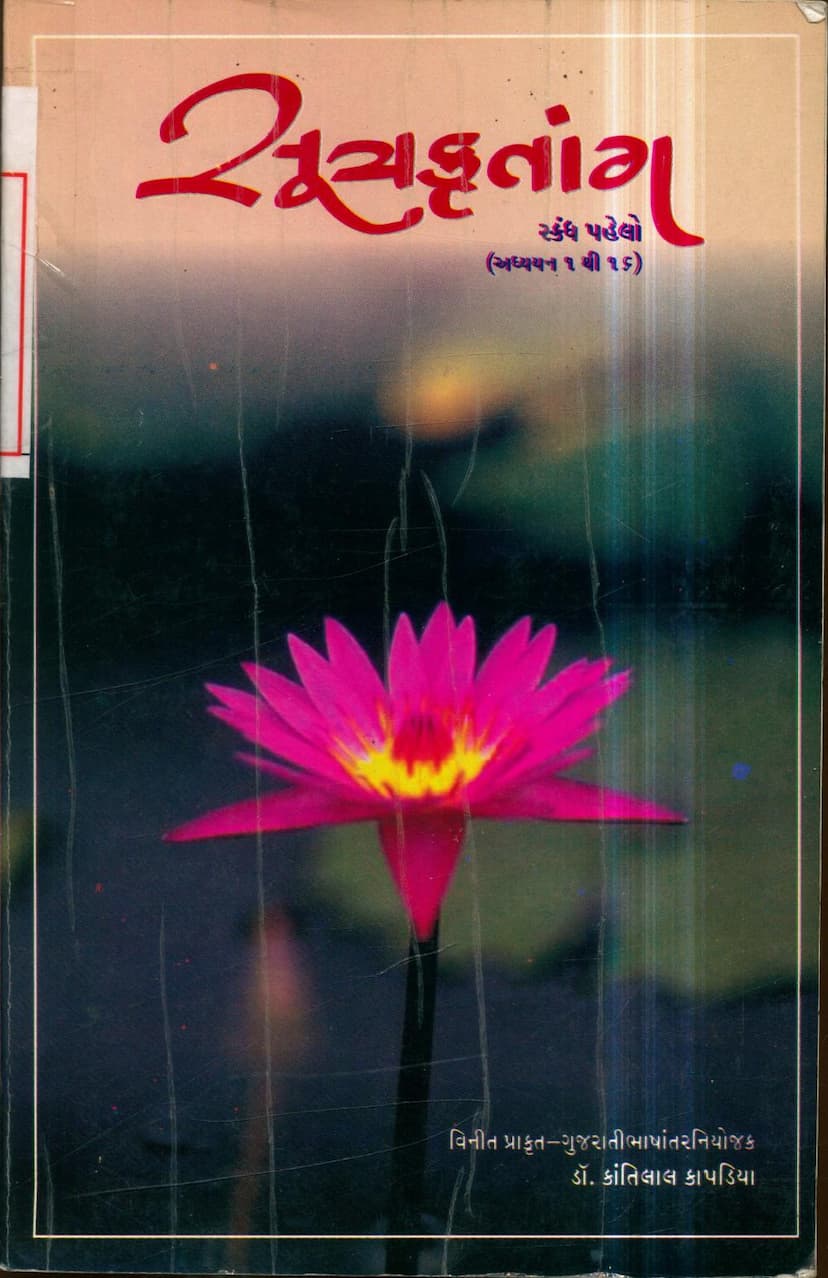Sutrakritang Skandh 01
Added to library: September 2, 2025

Summary
Certainly, here's a comprehensive summary of the provided Jain text, Sutrakritang Skandh 01, based on the scanned pages:
Sutrakritang Skandh 01: A Comprehensive Summary
This document represents the first Skandha (section) of the Sutrakritang, a fundamental Jain scripture, specifically covering chapters 1 to 16. The work is presented as a "Vinit Prakrit-Gujarati Translation" by Dr. Kantilal Kapadia, published in Mumbai in 2005.
Overall Purpose and Author's Intent:
The author, Dr. Kantilal Kapadia, expresses his satisfaction in publishing this translation after about ten years of work. He emphasizes that the translation is largely literal, encouraging readers to also consult the original Ardhamagadhi text to understand the nuances of the Devanagari script and the language. He humbly requests forgiveness for any grammatical errors and suggests consulting scholars or monks for clarification. Dr. Kapadia hopes this work will be useful for students and generally beneficial for Jainism. He highlights the importance of establishing a Jain university for research to counter the deviation of current practices from Lord Mahavir's principles.
Significance of Sutrakritang:
The author notes that Sutrakritang is a valuable text that helps ascetics remain steadfast in their discipline. It also provides insights into the philosophies of non-Jain thinkers. He points out that Lord Mahavir is referred to as a "Brahmin" in the text, and the 16th chapter defines a true Brahmin. He also explains that Lord Mahavir was called a Kshatriya due to his struggles against the world and a Maharishi due to his unparalleled knowledge and perception. His message of action makes him a Shraman. The author feels that establishing a university is a small way to repay the debt owed to Lord Mahavir's teachings.
Core Jain Principles Emphasized:
- Samayaktva (Right Faith/Perception): Defined as treating all beings equally, protecting them with self-control and vigilance, and practicing restraint in thought, word, and deed.
- Overcoming Sectarianism: The text stresses the need to overcome the limitations of sectarian beliefs that lead to loss of control over passions. Principles are above sectarian divisions, requiring generosity to bridge these gaps. Unity among Jains strengthens the significance of Jainism.
Summary of Chapters 1-16 (First Skandha):
The document then provides a detailed outline of the 16 chapters, with summaries of their main themes and objectives (Uddeshak):
- Chapter 1: Samay (Time/The Self): Discusses the concept of the self, bondage, the five great elements (Panch Mahabhuta), nihilism, determinism, karma, and the views of various philosophers. It critiques ideas of self-creation and the non-existence of karma, sin, and virtue.
- Chapter 2: Veyaliyam (Destiny/Karma): Focuses on the cessation of karma. It covers the idea of enlightenment, impermanence, renunciation of pride, and the importance of abandoning attachment and negligence. It also critiques those who follow wrong paths.
- Chapter 3: Usavagaparinna (Endurance of Hardships): Deals with the contemplation and endurance of hardships. It discusses favorable and unfavorable situations, despair, accusations, fallacies, and provides systematic guidance for the deluded.
- Chapter 4: Isthiparinna (Women): Advises against attachment and association with women, describing them as deceptive and the cause of downfall.
- Chapter 5: Nirayavibhakti (Hellish Realms): Describes the various hellish realms, indicating the consequences of sinful actions.
- Chapter 6: Mahaviratthavo (Praise of Mahavir): A hymn or praise of Lord Mahavir, highlighting his supreme qualities.
- Chapter 7: Kusilaparibhasiyam (Criticism of the Unvirtuous): Details the faults of impure ascetics and advises virtuous monks to maintain their discipline.
- Chapter 8: Viryam (Effort/Energy): Discusses the two types of effort or energy.
- Chapter 9: Dhamme (Dharma/Righteousness): Defines the true path of righteousness taught by the Jinas, emphasizing detachment, humility, endurance of hardships, and renunciation of external and internal faults. It also stresses control over desires and the goal of liberation.
- Chapter 10: Samadhi (Concentration/Peace): Explains how to achieve peace and concentration.
- Chapter 11: Magge (The Path): Describes the path to liberation, the "winding road" of this world, and emphasizes that impure meditation does not lead to moksha.
- Chapter 12: Samavasaranam (The Congregation): Mentions the assembly of four types of heretics and references 363 different viewpoints, while promoting the doctrine of action (Kriyavada).
- Chapter 13: Ahuttahiyam (Truthful Speech): Explains the importance of truthful speech and the distinction between monks and non-monks.
- Chapter 14: Grantho (Attachment/Book): Discusses the importance of celibacy and overcoming difficulties in acquiring religious knowledge.
- Chapter 15: Yamatitam (Beyond Time/Control): This chapter is characterized by Yamak (rhyming) embellishments and discusses overcoming the world through pure intention. It also refers to the Tathagata's presence as being everywhere and similar to people's desires.
- Chapter 16: Gaha (Verse/Stanza): Explains who can be called a Brahmin, Shraman, Bhikshu, and Nirgrantha.
Concluding Remarks:
Dr. Kapadia expresses gratitude to those who supported the publication. He reiterates his hope that the book will be beneficial to religious people and students. He also expresses his intention to prepare and publish a glossary for this text to aid understanding.
This summary provides a structural overview and thematic highlights of the Sutrakritang Skandh 01 as presented in the provided Gujarati text.